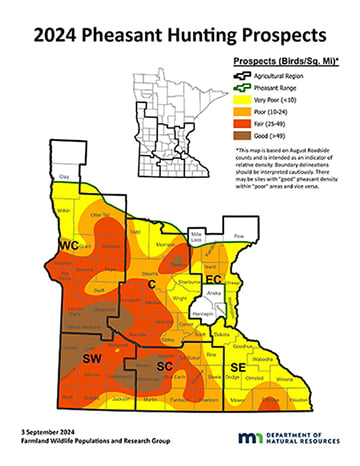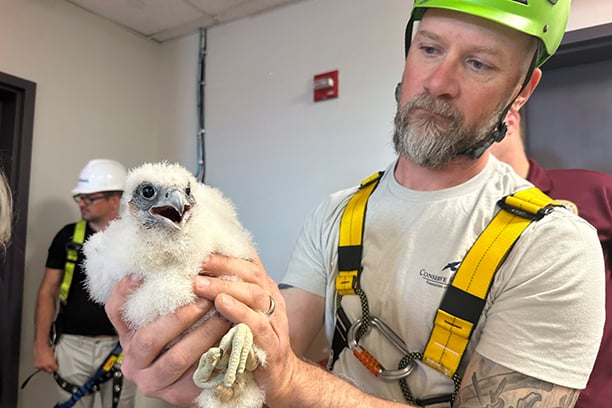Minnesota’s annual roadside survey shows statewide pheasant numbers similar to 2023 – Outdoor News
Pheasant numbers in the 2024 Minnesota August Roadside Survey were similar to 2023 and 19% above the 10-year average, the Minnesota Department of Natural Resources announced this week in releasing the results of the annual survey.
“The stability in pheasant numbers across the state and most regions is welcome news after the wet spring and summer we had,” said Steven Woodley, DNR senior wildlife research biologist. “Our milder winter meant more hens were available for nesting this year, which likely offset chick losses that occurred due to wet conditions during the breeding season.”
This year’s statewide pheasant index was 52 birds per 100 miles of roads driven, compared to 51 birds per 100 miles of road driven in 2023.

Pheasant numbers increased the most in the east central region (70%), followed by increases in the central (34%), south central (8%), and west central (6%) regions. Pheasant numbers declined in the southwest (29%), but the region still had the greatest number of birds (82 birds per 100 miles). This southwestern portion of the state is still expected to provide some of the best hunting opportunities in Minnesota.
Overall, the pheasant index in all regions remained below the long-term average. The total pheasant index statewide is generally similar to 2023. The DNR said milder-than-average winter conditions likely decreased bird mortality, equating to more adult birds carried over to the nesting season.
The number of broods per 100 hens and chicks per brood were down this year. The number of broods per 100 hens declined by 21% compared to the 10-year average, and the number of chicks decreased by 12%.
“Due to the above-average precipitation received in the spring and summer months, the decline in brood and chick numbers is unfortunately not surprising,” Woodley said. “The frequency of rain events and the amount of moisture received likely impacted nesting success and brood survival.”
MORE COVERAGE FROM MINNESOTA OUTDOOR NEWS:
Jeremy Smith: September can be a time to score big on muskies
What’s the impact of youth hunting seasons in Minnesota, Wisconsin?
Number of Minnesota small game hunters increased slightly in 2023
Weather and habitat are the main influences on Minnesota’s pheasant population trends. Weather causes annual fluctuations in pheasant numbers, while habitat drives long-term population trends.
Shifts this year are due to weather conditions, with adult pheasant populations benefiting from favorable winter conditions but nesting and brood-rearing being adversely impacted by the wet spring and summer conditions. The DNR notes that long term, there is nothing to suggest that some areas’ increase in pheasant numbers will continue as a trend, given that there is no corresponding increase in habitat.
The Minnesota pheasant hunting season opens at 9 a.m. Saturday, Oct. 12.
Partridge numbers increase in the southwest
Gray (Hungarian) partridge is a less frequently encountered game bird, and statewide partridge numbers decreased in this year’s roadside survey.
Partridge numbers increased by 50% in the southwest region, from 7.6 birds per 100 miles driven in 2023 to 11.4 birds per 100 miles driven in 2024. All other regions had less than 1.3 birds per 100 miles.
Habitat factors
Conservation Reserve Program acres play a large role in providing high-quality habitat for pheasants in Minnesota. The program, authorized under the federal Farm Bill, pays farmers to remove environmentally sensitive land from agricultural production and restore vegetation that will reduce soil erosion, improve water quality, and provide habitat for wildlife and pollinators.
Overall, there was a net increase of approximately 9,800 acres of protected wildlife habitat compared to 2023 due to increases in land enrolled in conservation programs. However, not all of those added acres were grassland.
Though total acres increased, the long-term trend in lands enrolled in the Conservation Reserve Program continues to decline. From 2023 to 2024, CRP saw a decline of 4,000 acres. The CRP acres play a large role in providing high-quality grassland habitat for pheasants in Minnesota.
Pheasant hunting areas
Many publicly owned lands are open to hunting, as are private lands enrolled in the state’s Walk-in-Access program. Hunters can use the Minnesota DNR’s online mapping tools to find WMAs by accessing the WMA finder and the Minnesota DNR Recreation Compass to locate both state hunting grounds and private lands enrolled in the Walk-In Access program, including updates on the condition of specific properties.
More information
The 2024 August Roadside Survey report, a map of pheasant hunting prospects, data for other surveyed species, and information on hunting regulations and bag limits are available on the Minnesota DNR pheasant hunting webpage.






